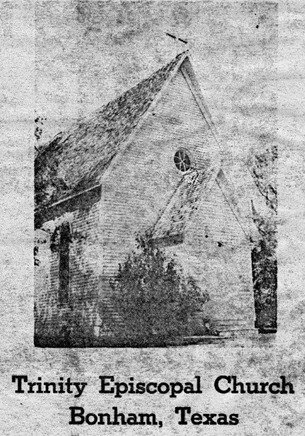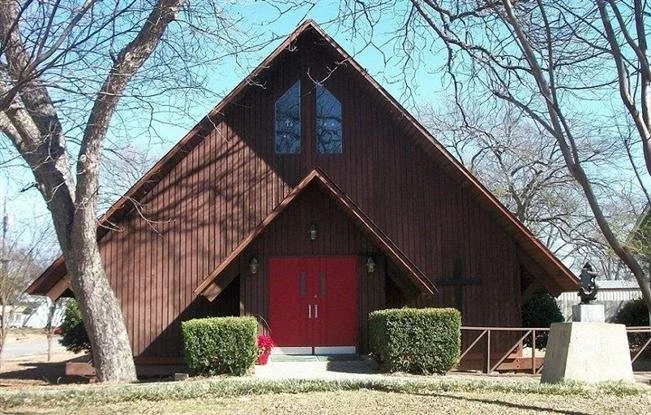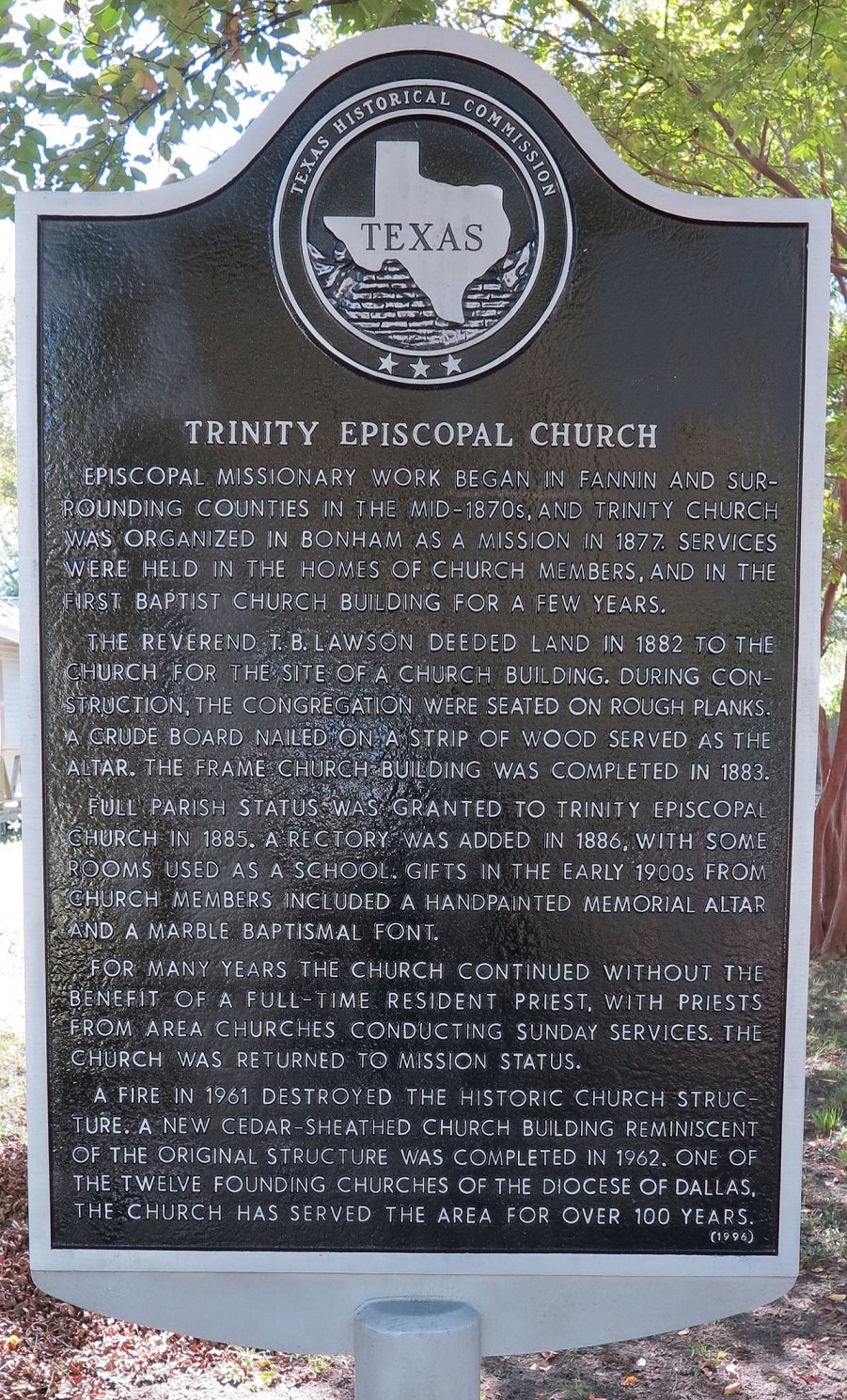Trinity Episcopal Church
Marker Text:
Episcopal missionary work began in Fannin and surrounding counties in the mid-1870s, and Trinity Church was organized in Bonham as a mission in 1877. Services were held in the homes of church members, and in the First Baptist Church Building for a few years.
The Reverend T. B. Lawson deeded land in 1882 to the church for the site of a church building. During construction, the congregation were seated on rough planks. A crude board nailed on a strip of wood served as the altar. The frame church building was completed in 1883.
Full parish status was granted to Trinity Episcopal Church in 1885. A rectory was added in 1886, with some rooms used as a school. Gifts in the early 1900s from church members included a handpainted memorial altar and a marble baptismal font.
For many years the church continued without the benefit of a full-time resident priest, with priests from area churches conducting Sunday services. The church was returned to mission status.
A fire in 1961 destroyed the historic church structure. A new cedar-sheathed church building reminiscent of the original structure was completed in 1962. One of the twelve founding churches of the Diocese of Dallas, the church has served the area for over 100 years.
Location: Star & West 7th Street, Bonham
Trinity Church of Bonham, Texas
By Tom Scott, Fannin County Museum of History
When Fannin county was hardly a year old and Bonham nothing more than a few scattered cabins near Fort Inglish, the first Episcopal Church in Texas was organized at Matagorda on January 27, 1839 by Caleb Semper Ives, appointed as Missionary to Texas by the Board of Missions of the Episcopal Church in the United States.
The Diocese of Texas, encompassing all the land between the Red River and the Gulf of Mexico, The Sabine River and Red River of New Mexico, was organized on January 1, 1849 at a session held at Matagorda. The Diocese was admitted into union with the General Convention on October 4, 1850. Alexander Gregg, in 1859, became the first resident Bishop.
The Rev. Father Richard Morgan, long-time Rector of Holy Trinity Church in Bonham, interviewed several members of his congregation, soon after his arrival in Bonham. These persons were members of some of the founding families of the Church and had seen the Episcopal influence as it began to flourish in Northeast Texas.
The Rev. Morgan wrote that Bishop Gregg visited in Bonham before the Civil War, traveling here by stagecoach. Additionally he made several visits to the area around 1870. His frequent traveling companion on these visits was The Reverent Francis Starr who was to later take part in the development of the Missionary District of Northern Texas.
Alexander C. Garrett was consecrated Bishop of the newly created Missionary District of Northern Texas at Omaha, Nebraska on December 20, 1874. On his arrival at Dallas eleven days later he discovered that he had only five co-workers to assist him in a district that covered approximately one hundred thousand square miles and included only twelve stations.
Of these five men Bishop Garrett appointed the Reverend Francis Starr to take charge of the missionary work in the counties to the east of Fannin County. The Reverend Starr resided in Paris and frequently visited in Bonham for the four years after his appointment. At the first Convocation of the Missionary District he reported five communicants in Bonham.
In 1875 The Rreverend E. W. Gilliam of St. Joseph's Church in Sherman was placed in charge of the missionary work for a large section of northeast Texas. Included in his charge were the counties of Fannin and Grayson as well as the counties to the west and south of Fannin. The Reverend H. O. Crane succeeded The Reverend Gilliam on his transfer t Missouri in 1876. The Reverend Crane died in Sherman a short time later and was succeeded by The Reverend F. W. Adams of St. Luke's Church, Denison.
In 1877 The Reverend Doctor T. B. Lawson, of Tennessee, arrived in Sherman to take charge of the Missionary District. At the convocation of 1877 he reported a communicant list of nine teen members at Bonha. Doctor Lawson was transferred to Louisiana in 1878 and remained there until the latter part of 1879 when he returned to again take charge of the Church's work in Sherman, Bonham, and Honey Grove.
After the 1877 convocation, application was made to Bishop Garrett to organize a mission in Bonham. The August 2, 1877 petition was signed by Dr. A. B. Hoy, a Bonham Physician, George A. Preston, Cashier of the Fannin Bank and Trustee of the University of the South, Richard B. Semple, local attorney, brothers Arden and George Anthony, merchants, H. F. Peters, a gunsmith, Dr. Benjamin Dabney, Bonham physician, O. B. Phillips, Bonham dry goods merchant, John Faas, agency for the Texas and Pacific Railway, Harold Gooch, a dry goods salesman, and the only woman, Mary Lewis, a local milliner.
Bishop Garrett gave his consent on September 22, 1877 and the mission was named Trinity Church. Dr. Hoy was elected Warden, Mr. Preston, Treasurer, and Mr. Semple, Secretary. For the next four years, lacking a permanent place in which to worship, services were conducted in the homes of various members. However, through the generosity of the board of the First Baptist Church, their building was frequently made available to the small but growing congregation of Trinity Church. During this time the Reverend J. P. Lytton was put in charge of the churches in Bonham and Honey Grove.
With the return of Dr. Lawson in 1879, Bishop Garrett reported that in 1880, "Bonham and Honey Grove do not increase rapidly, but they are blessed by the able and faithful missionary labor of the The Reverend t. B. Lawson."
On May 9, 1881, on land owned by The Reverend Lawson, the cornerstone of Trinity Church was laid, marking the beginning of construction of a new church for the Bonham communicants. Bishop Garrett, presiding at the ceremonies, said that "Dr. Lawson is universally beloved by all classes of the community and is in fact a sort of walking book of reference upon all questions in controversy among disputations of dwellers on the banks of the Bois d'Arc."
September 27, 1882, The Reverend Lawson deeded to Bishop Garrett, for the sum of $5.00, the property on which the Church was being constructed. The property, as described in the records consisted in 1/2 acre of Block #17 of the Williams Addition to the city of Bonham.
In November of 1881, Bishop Garrett, returning from the General Convention in New York, stopped in Meadville, Pennsvylvania to preach and lecture on the missions in Texas. Afterward the rector of the church, where he spoke, had an offering taken for Trinity Church in Bonham.
Bishop Garrett visited Bonham again on April 24, 1882 and reported that "Trinity Church is so far advanced that I was able to hold services there. A rough plank nailed on a strip served as an altar. The congregation were seated on benches borrowed from the Baptists and partly on rough planks supported on such things as could be obtained. Too much praise cannot be given Dr. Lawson for his increasing labor in carrying on the work. The people also have nobly seconded his labor."
Bishop Garrett's reference to the support of thhe people of Bonhaam is borne out in news items from The Bonham News. The December 8, 1880 edition of the paper reported that "Ladies of the Episcopal Church circulated a subscription paper yesterday for the purpose of raising the funds to build a church for that denomination in this city. When we saw the list there was $789.50 on it. This certainly does pretty well for one afternoon's work."
In the same paper one week later was a brief notice that a concert for the benefit of the Episcopal Church will "take place on the 28th and 29th of this month at the new opera house. Assistance is expected from the best musical talent from Sherman and Honey Grove."
Construction was completed in the Spring of 1883 with no indebtedness on the part of the congregation. Bishop Garrett returned for the consecration services on Trinity Sunday, May 17, 1883.
Dr. Lawson retired in 1884 and was succeeded by The Reverend A.G. E. Jenner, Deacon. On May 7 of that year Trinity Church, with the Bishop's consent, applied to be admitted to the District as a parish. At the Convocation of 1885 the little Northeast Texas mission received full parish status. Soon after The Reverend Jenner oversaw the addition of a vestry room to the building.
Jenner was transferred at the end of the year and was succeeded by The Reverend C. T. Denroche.
In a report to Bishop Garrett, The Reverend Denroche said that the newly founded parish was in "a time of hopeful promise, with a weekday service and Bible class a realized success." In the summer of 1886 a set of beautiful communion vessels were presented to Trinity Church by the Church of the Transfiguration in New York City and were blessed and used by Bishop Garrett for the first time.
Also in 1886 a Rectory was completed on property just to the south of the church. One room was retained for the use of the missionary and the other rooms were rented for use a school.
Membership in the congregation continued to grow slowly over the next decade with the growth interspersed with periods of decline. On All Saints Day, 1896, The Reverence J.B.C. Beaubien began to guide Trinity Church into a period of growth and improvement.
The rectory was moved to a new site west of the church and many improvements were made making it more suitable as a family residence. Under Beaubien's guidance the congregation began to grow, an altar guild was organized and a choir was incorporated into all the services.
In 1905 The Reverend Samuel G. Porter arrived to take charge of Trinity Church. Over the next two years additional improvements were made to the church property. The Reverend and Mrs. Porter presented, as a memorial to their daughter, a beautiful new altar which was designed and constructed by The Reverend Porter. Three panels, decorating the front of the altar, were painted by Miss Charlie Phillips, local art teacher, and member of Trinity Church.
A richly ornamented altar cross was given by Mrs. Horace C. Alexander in memory of her husband. The congregation donated funds for the purchase of a new chancel rail and prayer desk. Miss Katherine Phillip's Sunday School class donated a leatherbound altar edition of the communion service. Ed Anderson designed and made the marble baptismal font still in use today. All of these gifts were consecrated by Bishop Garrett on May 6, 1906.
Trinity Church welcomed on July 15, 1906 a recent graduate of the Virginia Episcopal Seminary as the new rector. The Reverend Richard Morgan began a tenure at Trinity church which lasted longer than any before or since. With the exception of the year 1918, when he worked with the American Y.M.C.A. on the European battlefields of World War I, The Reverend Morgan labored mightily for Trinity Church.
Ill health forced The Reverend Morgan to curtail his activities at Trinity Church. In 1927 he was forced to retire completely. However, for the next thirty or so years, whenever trinity Church needed him, he was always willing and eager to serve in whatever capacity he could. Most often he filled the position as temporary or acting priest for those times when Trinity Church had been left without the ministrations of a resident or visiting priest.
From the late 1920's until 1947, Trinity Church was without the services of a resident priest and was served by a series of visiting priests from area churches. In November of 1931, Trinity Church closed because of declining membership and inadequate financial support. The church remained closed until February 1936. During that time the rectory was sold and moved from the lot.
In the summer of 1947 The Reverent Charles G. Kehler, former missionary among the Indians at Blind River, Ontario, Canada, arrived to take charge of Trinity Church. He was succeeded in 1949 by The Reverend Rex C. Sims who remained until January 1951.
During Sims' tenure the old Methodist Church building at the rural community of Edhube was purchased with the money saved from the sale of the rectory. The building was moved to the lot South of the church and used as a Parish House for Trinity Church.
In April, 1961 The Reverend J. D. Maurer took charge of Trinity Church. Only a few days later, Trinity Church sustained its most devastating loss. On April 18, 1961, during the noon hours, Trinity Church was almost totally destroyed by fire.
When the fire department arrived on the scene the entire roof and attic area were engulfed by flames. Although the firemen fought for over an hour the flames had gained too much headway and it was impossible to save the building. All that remained were the lower walls and a small section of the roof. Church members and some neighbors were able to save all the vestments and appointments on the altar but the organ and pews were destroyed or badly damaged. At this destruction Trinity Church was the oldest extant church building in Bonham.


